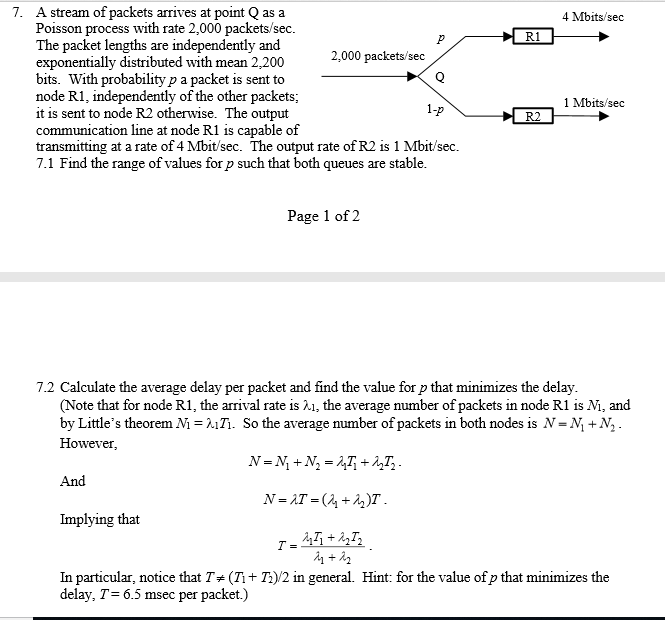
4 Mbit/sec - R 7. A stream of packets arrives at point as a Poisson process with rate 2,000 packets/sec. The packet lengths are independently and exponentially distributed with mean 2,200 2,000 packets/sec bits. With probability p a packet is sent to RO node R1, independently of the other packets; it is sent to node R2 otherwise. The output 1-p communication line at node R1 is capable of transmitting at a rate of 4 Mbit/sec. The output rate of R2 is 1 Mbit/sec. 7.1 Find the range of values for p such that both queues are stable. 1 Mbits/sec R2 Page 1 of 2 7.2 Calculate the average delay per packet and find the value for p that minimizes the delay. (Note that for node R1, the arrival rate is 1, the average number of packets in node R1 is Mi, and by Little's theorem Ni = 2.171. So the average number of packets in both nodes is N=N+N2. However, N=N, + N2 = 1,7+ Iz And N = AT =(4+1) Implying that 7 171 + 2z in + In particular, notice that T(T1+T2)/2 in general. Hint: for the value of p that minimizes the delay, T=6.5 msec per packet.) 4 Mbit/sec - R 7. A stream of packets arrives at point as a Poisson process with rate 2,000 packets/sec. The packet lengths are independently and exponentially distributed with mean 2,200 2,000 packets/sec bits. With probability p a packet is sent to RO node R1, independently of the other packets; it is sent to node R2 otherwise. The output 1-p communication line at node R1 is capable of transmitting at a rate of 4 Mbit/sec. The output rate of R2 is 1 Mbit/sec. 7.1 Find the range of values for p such that both queues are stable. 1 Mbits/sec R2 Page 1 of 2 7.2 Calculate the average delay per packet and find the value for p that minimizes the delay. (Note that for node R1, the arrival rate is 1, the average number of packets in node R1 is Mi, and by Little's theorem Ni = 2.171. So the average number of packets in both nodes is N=N+N2. However, N=N, + N2 = 1,7+ Iz And N = AT =(4+1) Implying that 7 171 + 2z in + In particular, notice that T(T1+T2)/2 in general. Hint: for the value of p that minimizes the delay, T=6.5 msec per packet.)







